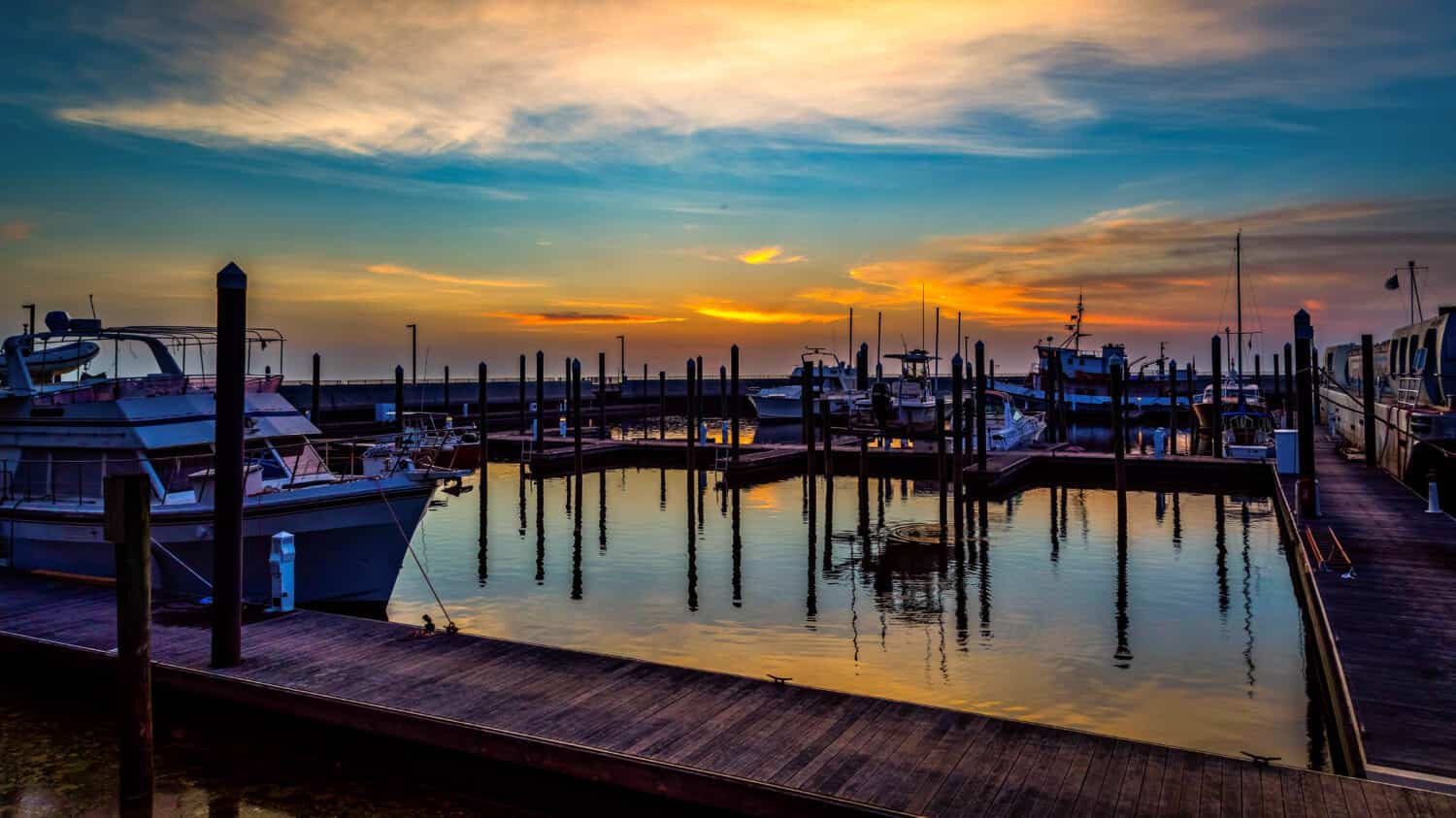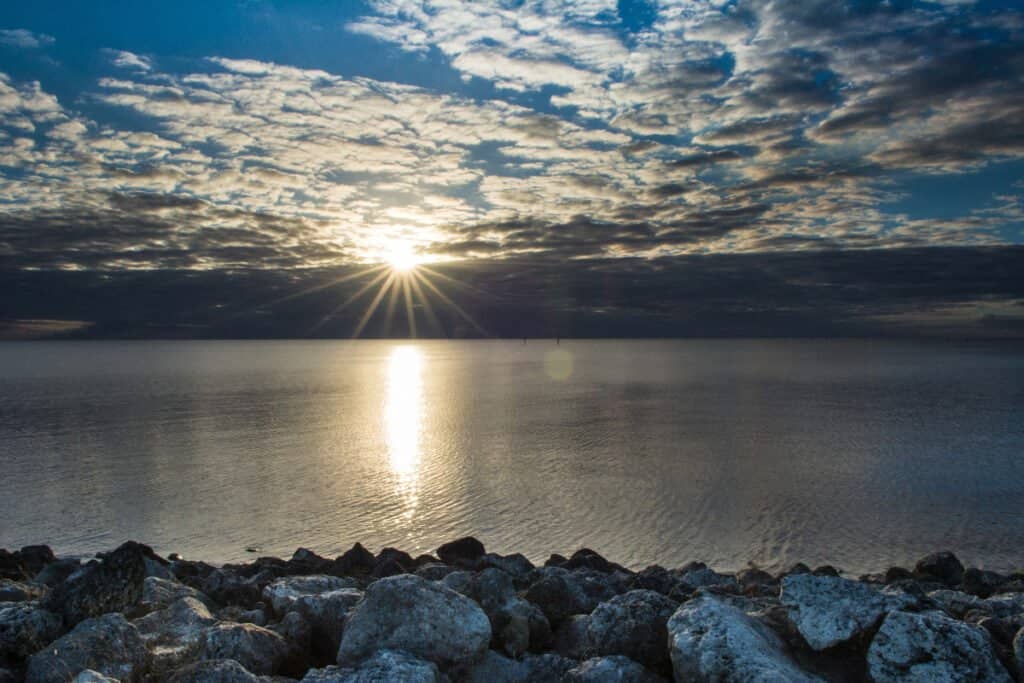
Lake Okeechobee offers stunning views at any time of the day.
©Allison Michael/Shutterstock.com
Polluted Lake Okeechobee may look stunning in pictures, but it isn’t a place you’d want to visit.
Lake Okeechobee is a huge lake. It is so big it sits within five different counties within Florida. The lake was once a popular destination to spend the day with family and was lovingly referred to by the locals as their own private inland sea.
Unfortunately, pollution has turned this once beautiful lake into something a lot darker and more dangerous. The polluted Lake Okeechobee is now more for stunning photos and maybe boat rides than a place you take your family.
While Florida has had some success stories with reducing water pollution in lakes, Lake Okeechobee isn’t likely to be one of those any time soon. Efforts and a plan have been established to make a change, but the cost of such a venture, dealing with the politics from five different counties, and the sheer size of the lake make it very difficult for a permanent fix to the pollution in this lake.
Where Is Lake Okeechobee?
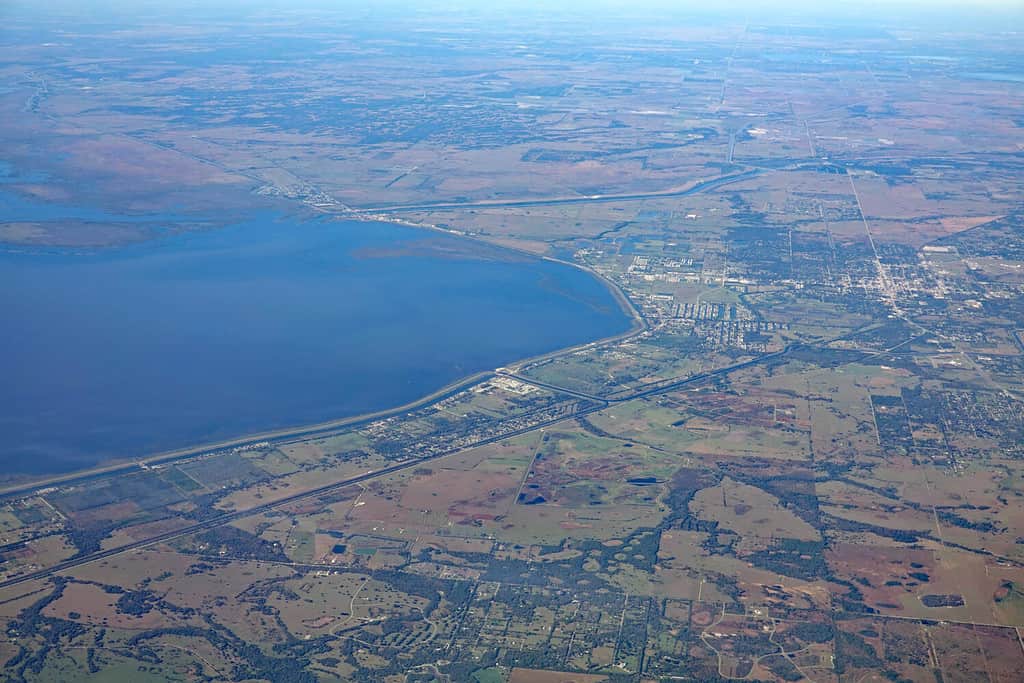
Lake Okeechobee is so large it’s impossible to see the other side from anywhere.
©Thomas Barrat/Shutterstock.com
Lake Okeechobee is located in Florida. It’s in the southernmost area of Florida, about 40 miles northwest of West Palm Beach. The lake is large enough to be a part of Okeechobee, Martin, Palm Beach, Hendry, and Glades counties.
Though it’s a little north of the Everglades, it’s considered to be part of the watershed because Kissimmee River goes through the lake, into the Everglades, and the ocean eventually. It’s considered a valuable lake as well because it’s part of Florida’s water supply and makes up a large part of the flood control system.
About Lake Okeechobee
Lake Okeechobee is often called Florida’s inland sea as it’s the largest lake in Florida. The locals also refer to it as “Big O” sometimes. It stretches out over 730 square miles. It is 36 miles long and 29 miles wide at its largest points.
Despite this, it’s a relatively shallow lake. On average, it only reaches nine feet deep. Even at the deepest part of the lake, it’s only 13 feet. Sometimes, in rainy years, it can get as deep as 18 feet. This is incredibly shallow considering that other lakes its size are at least 30 to 40 feet, but usually closer to 300 or 400 feet.
The bottom of the river is made up of clay, leading to mushy earth under the water that is often called “muck”. Roughly 60% of its water comes from Kissimmee River.
It’s the second-largest lake in the US. That is, it’s the second largest lake in the US if you only consider 100% freshwater and contiguous lakes in the United States. The only one larger than it would be Lake Michigan. However, if you consider just the size of the lake, it’s in 10th place.
Animals in the Lake
Despite the heavy pollution and shallow depth, Lake Okeechobee is teeming with wildlife. You will find American alligators, bull sharks, and all sorts of snakes. Ducks and fish are also present in the area.
Though there are large die-offs during algal blooms, it isn’t enough to render the lake sterile. Fish from the rivers, or those that managed to avoid the toxins when the algae bloomed will repopulate the lake.
Animals also start to adapt to the pollution. They become able to handle larger levels of pollution while still living. Though they can survive, they aren’t thriving by any means.
Pollution in the lake leads to difficulties in growing and reproducing. Sometimes, they may have disabilities that make it difficult to reach maturity or that cause health issues.
Lake Okeechobee Water Pollution
Unfortunately, Lake Okeechobee is heavily polluted. It’s considered to be the most polluted lake in the entirety of Florida. This is even more serious when you realize that Florida is considered to have some of the most polluted bodies of freshwater in the world.
In 2022, a study done by the Environmental Integrity Project found that Florida has the most polluted lakes throughout the United States. The pollution in some of these lakes is so high that it’s considered unsafe for people to swim or for aquatic life to thrive.
A total of 900,000 acres worth of lakes are considered heavily polluted in Florida. Another 2,500 acres of estuaries are polluted. This number makes up over 99% of all the estuaries tested during the study.
Out of all these acres of lakes, Lake Okeechobee accounts for half of the total, at 450,000 acres. Florida has a 140 metric ton limit for how much phosphorus should be in a lake. Lake Okeechobee has over four times that set standard in its water, and likely much more in the soil at the bottom of the lake.
Because of the heavy pollution, there have been several environmental concerns and warnings when the pollution gets even heavier than normal. It’s especially problematic that Florida has so much pollution in its freshwater because Florida is home to many unique species. The Everglades, mangroves, and estuaries are homes to endangered species. High levels of pollution harm these animals and make the water uninhabitable for them in the future.
Common Pollutants in Lake Okeechobee
Most of the current pollutants in Lake Okeechobee are from farming practices and stormwater. Farming runoff is a huge problem in many bodies of water. Not only do you have high levels of nitrogen and phosphorus from fertilizer or manure, but there are high levels of pesticides, insecticides, and fungicides that the rain pulls in and carries on to large bodies of water like lakes, and eventually oceans. These contaminants can also absorb into the soil and pollute the groundwater, even without rain.
Stormwater and runoff also have similar problems. It still has the potential to bring in all of the pollutants from farms. It also brings in dirt, oil, bacteria, gas, and trash that may be lying on the surface of the ground, roads, and cemented areas.
Lake Okeechobee’s Biggest Problem
The biggest problem in Lake Okeechobee is the phosphorus. Most of the current pollution comes from runoff from nearby farms and stormwater. While these runoffs bring in all sorts of toxins like pesticides and nitrogen, phosphorus is the biggest issue.
Phosphorus is a large problem because bacteria feed off of it. While certain levels of bacteria in lake waters are normal, and even healthy, too much leads to what is known as an algal bloom.
These algal blooms, despite their name, are when bacteria in the water grow out of control. Too much bacteria in the water leads to toxic effects for anyone that decides to go swimming, and any wildlife that lives in or uses the lake.
In Lake Okeechobee, the algal blooms are of a blue-green variety. These are caused by cyanobacteria. When a bloom occurs, you may see green streaks or foam throughout the water. It may also change the color of the water to green, brown, red, or blue.
It’s harder to see signs of algal blooms in Lake Okeechobee due to its makeup. Because of something called tannins in the water, it already has a brownish-red color. So if the algal bloom causes the water to turn more red or brown, it’s not always noticeable.
Sometimes, the only way an outbreak is noticed is when water samples are taken and studied. This is why it’s important to pay attention to local water warnings and watch the weather.
Dangers of Swimming in the Lake
While pollutants are always present in the water, for a few days after rain, the problems get much worse. It’s a standard practice in any body of water where runoff is common to wait at least three days since the last rain before going back into the water.
Children, livestock, and pets should be kept away from Lake Okeechobee during the outbreaks. This is because they aren’t always able to stop themselves from drinking the water. Because of the toxins this cyanobacterium consumes, it has the potential to kill people and animals that ingest it.
Signs of sickness from drinking this water can be delayed as well. You may not notice signs until several hours or even several days after swallowing these toxins.
While not every algal bloom is toxic, there’s no way to tell if an outbreak is toxic or not just from looking at it. That’s why it’s best to avoid these outbreaks when possible and to avoid letting pets and children play in it.
Additionally, eating animals from bodies of water that have an outbreak can lead to similar issues. It’s best to avoid these waters whenever an outbreak occurs. At the very least, you don’t want to eat or drink from the water at all.
Some of the common symptoms of toxicity from algal blooms include stomach pain, vomiting, headaches, fever, throat irritation, weakness, and dizziness.
Smell
A smaller danger is the smell that comes with these algal blooms. While this doesn’t pose much physical harm, the horrible smell is enough to detract many people from visiting the area.
As algae die off, it leaves behind a horrible smell. At first, the smell is reminiscent of rotting plants. This is already bad enough but as time goes on the smell gets worse. By the time the plants die off, there may be a bad enough smell to entice vultures to stop and hang out.
Changes to Lake Okeechobee’s Pollution Problem
Many groups are trying to push for less pollution in the lake. The state government, scientists, and the Army Corps of Engineers are all working together to mitigate problems.
Unfortunately, this is something they’ve been working on for decades. Right now, the most feasible option is to drain the lake, clean out all of the pollutants, and build a new lake.
The main problem is that, even if methods are implemented to reduce the pollution already in the lake, currently there is no way to stop pollution from getting into the lake. Agricultural and storm runoff are two huge problems affecting any bodies of water throughout the world and there’s not yet been a way found to stop the pollution from happening.
So even if the lake gets cleaned, it will become polluted again in no time. It’s an unfortunate truth that keeping freshwater clean isn’t the easiest thing to do currently. There are a lot of politics involved that get in the way of making changes.
Additionally, some of these changes include stopping the use of chemicals and phosphorous-rich fertilizers in farming. This hurts the companies supplying these chemicals and fertilizers. It also hurts the farmers, as they are producing fewer crops and more are attacked by plants and fungus during the growing season.
So while there are plans in place to clean up Lake Okeechobee, whether it will actually get clean and stay cleaned, and how long it will take are still up in the air.
Another Polluted Lake in Florida
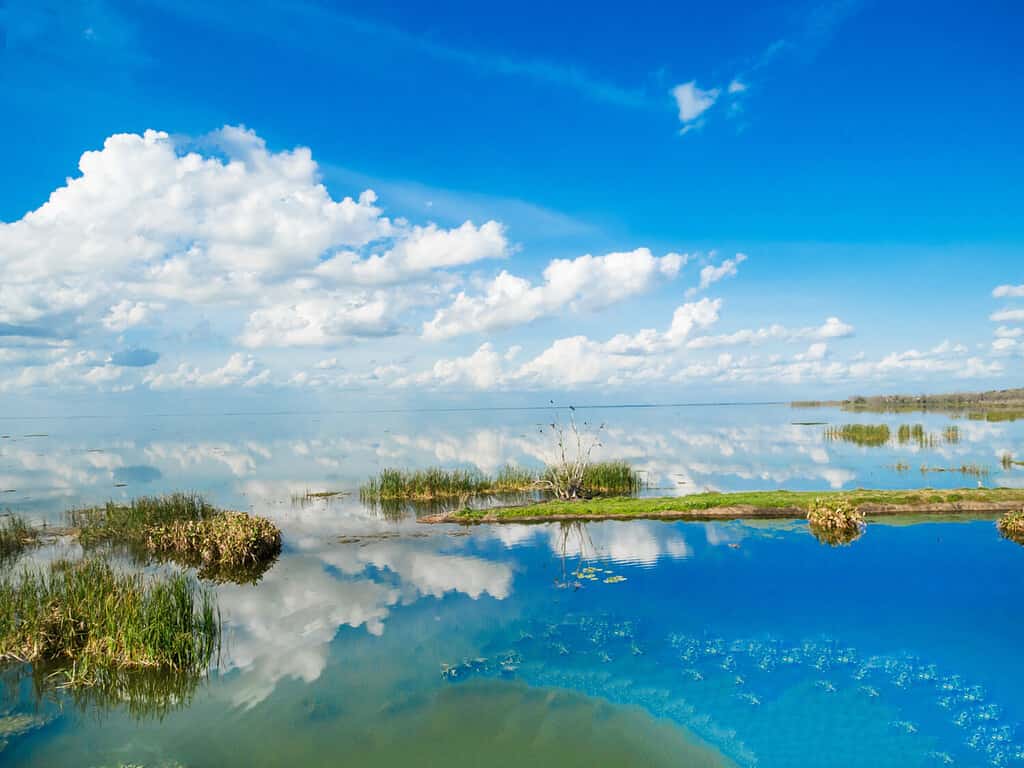
Lake Apopka was once known as the most polluted lake in Florida.
©Timothy OLeary/Shutterstock.com
While Lake Okeechobee takes up half of the total polluted freshwater in Florida, it isn’t the only polluted lake by any means. Another lake well known for its pollution is Lake Apopka.
Lake Apopka was once a beloved fishing destination. Unfortunately, runoff from nearby farms and stormwater caused frequent algal blooms. In time, the plants started to suffocate as the blooms ate off all the oxygen. The water quality grew worse, and only the brave or uneducated kept fishing there.
The story isn’t all bad though. At one point, pollution became so bad in Lake Apopka that it was considered the most polluted lake, even over Lake Okeechobee. Thanks to mitigations to improve the wildlife, filter out phosphorus, and habitat restoration, the lake has made huge improvements.
Farms from the north that provided most of the pollution were slowly bought and changed to habitat restoration. The water isn’t in perfect condition now, but it stands as a tale of the changes that can be made when groups come together to stop pollution and make a change. Overall, it can be considered a success story, though one still in the making.
Using Lake Apopka’s Success as a Guide
The same plan could be put in place to fix Lake Okeechobee, but it’s not quite as easy. For one, Kissimmee River picks up a lot of pollution as it makes its way to Lake Okeechobee. So it would take a lot of land purchases to fully stop agricultural runoff.
Additionally, the size is a problem. While they could filter the sediment and remove phosphorous, the size and constant addition of new phosphorous every time it rains means it would eventually turn into a never-ending cycle that only mitigated any additional pollution, and didn’t reduce the chemicals already in the lake.
It’s still definitely a possibility, but it isn’t going to be easy, and a lot more planning needs to be done.
The Cleanest Lakes in Florida
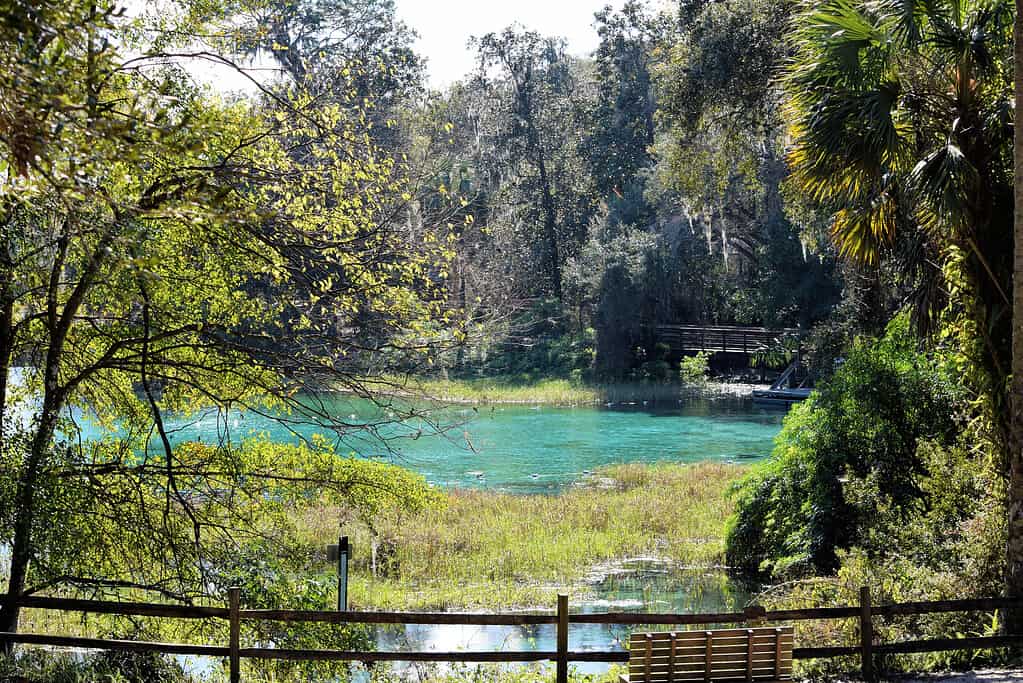
The gardens at Rainbow Springs in Dunnellon, Florida, and the clean water make for a beautiful site.
©natureexplorer2/iStock via Getty Images
The cleanest lakes in Florida are in Lake City, Wakulla Springs State Park, and Florida State Park. These are Rainbow Springs Lake, Wakulla Springs Lake, and Alligator Lake.
The first two manage to stay clean because they are constantly fed from fresh spring water. Spring water comes from underground, where the aquifer is. This also happens to be drinking water for many people in the state who use well water.
The last lake, Alligator Lake, manages to stay clean because it’s constantly monitored and controlled by the US Army Corps of Engineers. It is open to the public, though, if you want to stop and visit. In fact, all of these are open to the public. If you want to play in the water this summer, don’t go to the polluted Lake Okeechobee. Instead, pick one of these lakes to check out.
Thank you for reading! Have some feedback for us? Contact the AZ Animals editorial team.

